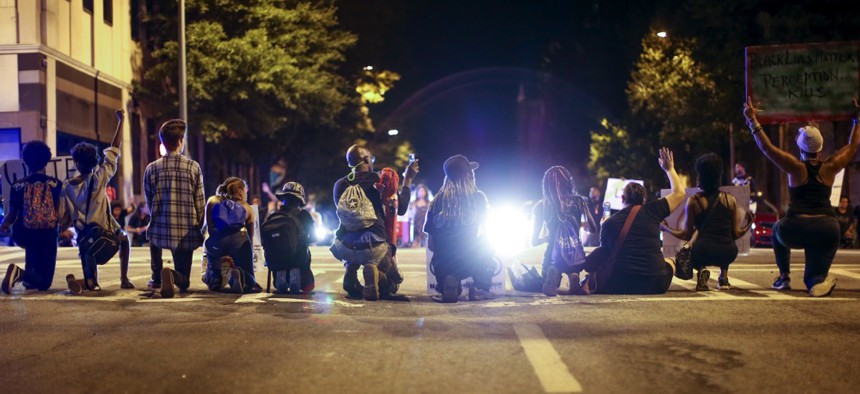Cities Have the 'Ability to Coalescence That Bottom-Up Movement' to Fix Racial Inequalities

Black Lives Matter protesters sit on Peachtree Street during a protest in downtown Atlanta on Saturday. Branden Camp / AP Photo

Connecting state and local government leaders
At a pivotal point in U.S. history, local governments and the private sector must collaborate to close opportunity gaps where the federal government cannot, according to social justice experts.
WASHINGTON — Local governments and the private sector are where innovations that improve racial equity should originate, according to “Race, Opportunity and U.S. Cities” panelists at an event on Tuesday celebrating the 25th Anniversary of Living Cities.
The New York City-based nonprofit, seeking better outcomes for low-income residents of cities, assembled the panel of experts to discuss closing racial gaps at the U.S. Institute of Peace in the nation's capital.
All agreed that the nation is at a critical point in its history, given all the recent demonstrations in cities like Charlotte, North Carolina. And city governments—along with philanthropies, nonprofits and businesses—must be the ones to pressure the federal government, which can help scale big ideas, to make social change happen.
“Local government has the ability to coalescence that bottom-up movement, particularly mayors sitting at ground zero,” said Blair Taylor, CEO of My Brother’s Keeper Alliance.
By 2044, the U.S. population will be majority minorities, said William Frey, a Brookings Institution demographer, during an earlier “Diversity Explosion” presentation, and the country has already entered a pivotal period in that transition.
Populations of Hispanics, Asians and people of two or more races will double thanks, in part, to an increase in interracial marriages.
“We could stop immigration tomorrow, not that we would … and become a more racially diverse country,” Frey said.
Cities that need growth like Omaha, Nebraska, are already benefiting from an influx of immigrants from Latin America, he said.
But racism remains institutionalized in government policies and rears itself in ways from housing discrimination to the shootings of young, black men by police, panelists said. Disillusionment has given rise to the Black Lives Matter social justice movement—advocacy that has been met with both support and vitriol.
“I’m not sure that America is ready for Black Lives Matter; in fact, the evidence shows a large portion of the country is not,” said Nick Turner, president and director of the Vera Institute of Justice. “That is a very inconvenient truth about our society right now, and it makes me want to rush to 2044, when we have more of a plurality.”
Behavioral change has been slow after an “incarceration binge” ignored by the establishment for decades, he added, one with a “coded connection between the color of one’s skin and criminality.”
Turner’s organization worked in New York testing empathy toward reform of “stop and frisk,” a police tactic opponents say is fraught with racial profiling, and found support dwindled when those surveyed were presented with images of black people being arrested, as opposed to whites.
Black Lives Matter hasn’t fared much better, its message obfuscated by cries of “All Lives Matter” or “Blue Lives Matter.”
“Immediately, people want to make it a conversation about something else,” said Angela Glover Blackwell, president and CEO of PolicyLink. “It is really extraordinary that black people cannot get the attention they need to solve a problem that is really in your face … All lives don’t matter unless black lives matter.”
Even the term “white privilege” takes a conversation about black suffering, she added, and turns it into one about white people.
While most of those in government who say they want to fight inequality are sincere, said Center for Social Inclusion President Glenn Harris, understanding the government structures that create it and giving people the tools to undo it is hard.
“Government created and maintained social inequity,” Harris said. “That was its central role for hundreds of years.”
Cities must attack it in how they handle seemingly unrelated issues like sewage, street lighting and garbage pickup, he added. Fortunately, residents trust their local governments far more than they do the federal government.
Aided by private sector research, cities can begin to promote shared prosperity.
“D.C. has an extraordinary engine of growth, but are the beneficiaries the longstanding residents of cities?” asked Sarah Wartell, president of the Urban Institute. “What are the metrics that we’re holding them to for inclusive growth.”
The Urban Institute has started doing “data walks” through neighborhoods accompanied by local residents, where they’re asked if the findings make sense to them—providing an added layer of insight.
Municipalities and the private sector should think of similar, digestible ways to feed their constituencies with facts, Turner said, like how prison policies permitting diversion to drug treatment actually improve public safety by reducing recidivism. Tweets and short videos are just the tip of the iceberg.
In the aftermath of Hurricane Katrina, no one was nervous—not the media, corporations or government officials, said Color of Change Executive Director Rashad Robinson. When that’s the case, there’s no sense of urgency or responsibility and government will do what it wants.
City leaders must make their racial equity demands clear, as well as the consequences if those demands aren’t met.
“My problem is with power,” Robinson said. “My community’s lack of power will determine our outcomes, and too often we mistake presence for power—being in the room.”
Dave Nyczepir is a News Editor at Government Executive’s Route Fifty and is based in Washington D.C

NEXT STORY: Empowering a Smarter Community Through GIS





